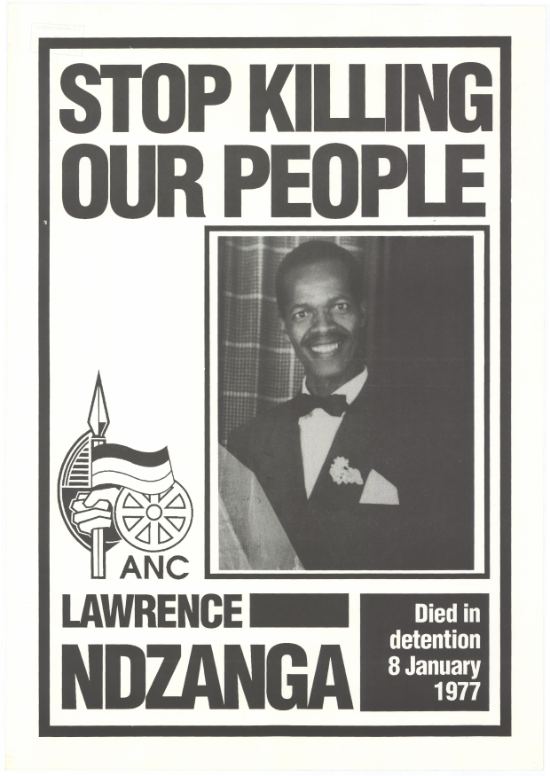 Under the leadership of Lawrence Ndzanga, the South African Railways and Harbours Workers' Union (SARHW) became an official affiliate of the South African Congress of Trade Unions (SACTU) in 1955. Ndzanga is remembered for his commitment to the struggle until his death in detention on 8 January 1977.
Under the leadership of Lawrence Ndzanga, the South African Railways and Harbours Workers' Union (SARHW) became an official affiliate of the South African Congress of Trade Unions (SACTU) in 1955. Ndzanga is remembered for his commitment to the struggle until his death in detention on 8 January 1977.
The politics of trade unions
SACTU was formed in the mid 1950s by trade unionists dissatisfied with the stance of the Trade Union Congress of South Africa (TUCSA), which excluded African unions from official registration. SACTU and its affiliates, including SARHW, saw trade union politics as a mechanism for confronting the overarching political oppression of the South African state. SACTU's position that industrial politics were directly linked to broader politics made it especially vulnerable to authorities.
Rita and Lawrence
During his years of involvement, Ndzanga travelled the country, recruiting members for the union. In 1956, he had married Rita Ndzanga, who became the union's secretary, responsible for collecting member's fees. The couple was also involved in an underground cell of four people, and became targets for banning and incarceration throughout the 1960s under Section 6 of the Terrorism Act and the Suppression of Communism Act. In 1969, they were represented by human rights advocate George Bizos. Lawrence Ndzanga continued to recruit for the underground African National Congress (ANC) during the early 1970s, until his death in detention on 8 January 1977. During this period, Rita was also detained, and released only on the day after her husband's funeral.
This is their history
In 1979, when SACTU celebrated its twenty five year anniversary, then-President Stephen Dlamini reminded members of the sacrifices made by its past members.
"...there stand thousands, nay tens of thousands, of South African workers who took the decisions, attended the meetings,(and) participated in the campaigns. Invariably, they suffered and made sacrifices in the pursuit of their ideals. Sleepless nights, anxieties, disruption of personal comforts and lives are a visible part of this record. Many paid the supreme penalty... in judging this record one must not forget these deep fountains of human courage, dedication and perseverance. This history is not just a memorial to a great organisation, but a tribute to all the brave, selfless men and women who were part of it... This is their history. They made it."
Rita Ndzangu went on to pursue a powerful role in struggle politics, elected as an active patron of the Federation of Transvaal Women (FEDTRAW) in December 1984. She served in the first three democratic South African Parliaments, and in 2004, was awarded the Order of Luthuli by then-President Thabo Mbeki.
SAHA and trade unions
SAHA has a number of archival collections related to the history of South African trade unions. These collections either contain the materials created or collected by particular trade unions, or images of various trade union activities, particularly from the 1980s.
View SAHA's trade union collections.
Between life and death: stories from John Vorster Square
Between Life and Death: stories from John Vorster Square is a virtual walk through the police cells on the 10th floor of South Africa's most notorious police station, where the security force reigned in apartheid South Africa. Commissioned by SAHA as part of the Sunday Times Heritage Project and filmed by Craig Matthews of Doxa Productions, the DVD features interviews with former detainees and security police as well as photographs, press clippings, drawing and other archival materials. Copies of the DVD are distributed to schools, educational and heritage organisations at various events and workshop.
Learn more about Between life and death: stories from John Vorster Square.





 Under the leadership of Lawrence Ndzanga, the South African Railways and Harbours Workers' Union (SARHW) became an official affiliate of the South African Congress of Trade Unions (SACTU) in 1955. Ndzanga is remembered for his commitment to the struggle until his death in detention on 8 January 1977.
Under the leadership of Lawrence Ndzanga, the South African Railways and Harbours Workers' Union (SARHW) became an official affiliate of the South African Congress of Trade Unions (SACTU) in 1955. Ndzanga is remembered for his commitment to the struggle until his death in detention on 8 January 1977.